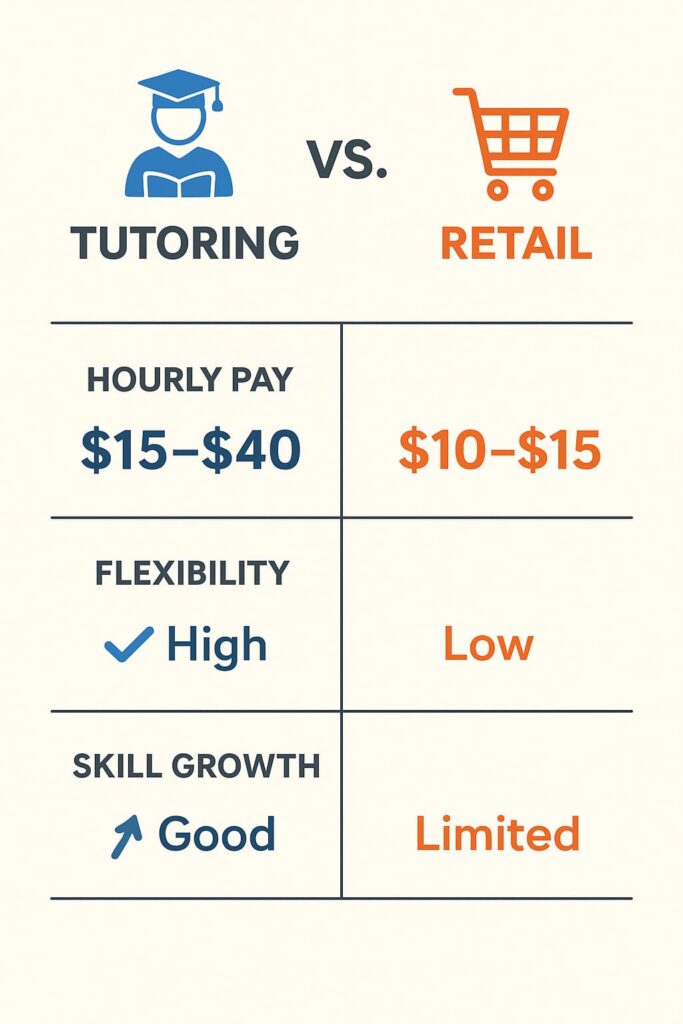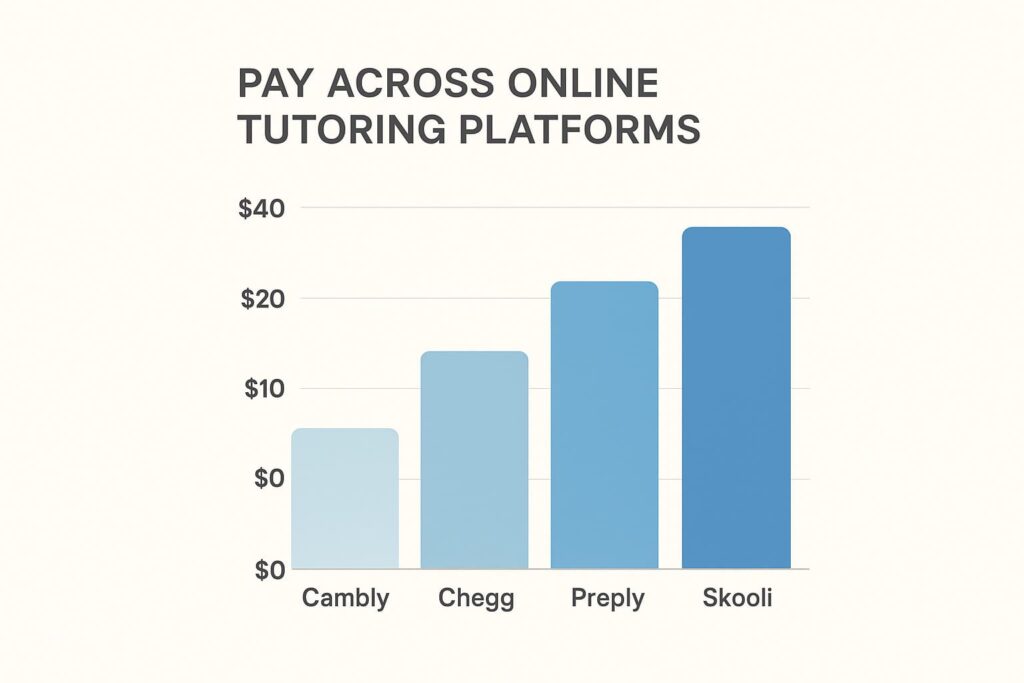Introduction
Being a student in the US, UK, or Canada isn’t cheap. Rising tuition fees, housing costs, textbooks, and daily living expenses make it challenging for many students to get by. While traditional part-time jobs like working in retail or hospitality provide some income, they often come with rigid schedules and relatively low pay.
That’s why many students are turning to online tutoring in 2025. It’s flexible, pays well, and allows you to leverage the knowledge you already have. Even without a teaching degree, you can earn anywhere from $15 to $40 per hour simply by helping others learn.
This guide will walk you through why online tutoring is such a great side hustle, what you need to get started, the best platforms for students, how much you can earn, and proven strategies to succeed.

Why Online Tutoring is Perfect for Students
Unlike many other side hustles, online tutoring aligns perfectly with a student’s lifestyle. Here’s why:
- Flexible Scheduling
You can tutor when you’re free — evenings, weekends, or even between classes. Most platforms let you set your own hours. - High Hourly Pay
Many student jobs pay minimum wage, but tutoring can pay two to three times that rate. Some specialized tutors even make more than $40 per hour. - Work From Anywhere
As long as you have a laptop and stable internet, you can tutor from your dorm room, home, or even while traveling. - Boost Your Resume
Tutoring strengthens your communication and leadership skills. It’s also an impressive addition to your CV or LinkedIn profile. - Sustainable Side Hustle
Unlike surveys or microtasks, tutoring builds long-term skills and repeat clients.

What You Need to Get Started
You don’t need to be a professional teacher to start. Most platforms are open to college students who are knowledgeable in their subjects. Here’s the checklist:
- Laptop or Tablet: A reliable device with webcam.
- Stable Internet Connection: At least 10 Mbps for smooth video calls.
- Headset with Microphone: Ensures clear communication.
- Knowledge in One or More Subjects: Math, English, science, coding, economics, or even music.
- Good Communication Skills: Being able to explain concepts clearly is more important than academic awards.
- Optional Certification: If you want to tutor English internationally, TEFL/TESOL certification can give you an edge.

Best Online Tutoring Platforms for Students in 2025
1. Chegg Tutors
Chegg is one of the most recognized platforms in the US. Students use Chegg not only for homework help but also for one-on-one tutoring sessions.
- Subjects: Math, business, engineering, computer science, science, and more.
- Pay: Around $20 per hour.
- Requirements: Must show proof of enrollment in a university or college.
- Why it’s good for students: Trusted brand, steady student demand, and straightforward application process.

2. Tutor.com
Owned by The Princeton Review, Tutor.com has been around for years. It offers professional tutoring across 250+ subjects.
- Subjects: Math, test prep (SAT, ACT), science, computer science, and more.
- Pay: Typically $15–$25/hour.
- Requirements: Some tutoring subjects require degree-level expertise, but many are open to current students.
- Why it’s good for students: Strong reputation and diverse subject areas.

3. Cambly
If you want the easiest entry point into tutoring, Cambly is your go-to.
- Focus: Conversational English practice.
- Pay: $10–$12/hour, paid weekly via PayPal.
- Requirements: None — just fluent English.
- Why it’s good for students: No qualifications needed, work flexible hours, great for beginners.

4. Preply
Preply is a global tutoring platform where tutors set their own rates.
- Subjects: Languages, business, math, coding, test prep.
- Pay: $15–$40/hour, depending on your experience and demand.
- Requirements: Profile creation, short intro video, and subject expertise.
- Why it’s good for students: Ability to scale your income and work with students worldwide.

5. Skooli and Wyzant
These platforms are better suited for more advanced tutoring but can be lucrative.
- Subjects: Advanced math, sciences, test prep.
- Pay: $20–$40/hour.
- Requirements: Higher credentials, sometimes degree verification.
- Why it’s good for students: Perfect for those excelling in academic fields who want serious tutoring work.
Step-by-Step: How to Become an Online Tutor
Getting started is easier than you think. Here’s the process:
- Pick Your Platform
Decide if you want easy entry (Cambly) or higher pay (Chegg, Preply). - Create a Strong Profile
Write a clear, friendly bio. Use a professional photo. Highlight your academic strengths and teaching style. - Verify Your Credentials
Upload student ID, transcript, or certifications as required. - Record an Intro Video (if needed)
Many platforms ask for a 1–2 minute introduction. Keep it professional, friendly, and engaging. - Start Accepting Students
Once approved, you can begin taking sessions. Start small, gain reviews, then raise your rates over time.
How Much Can Students Earn in 2025?
Your income depends on the platform, subject, and hours you dedicate.
- Cambly: $10–$12/hour, ideal for beginners.
- Chegg Tutors: ~$20/hour.
- Preply: $15–$40/hour depending on your rate and demand.
- Skooli/Wyzant: $20–$40/hour.
👉 A student working 10 hours per week at $20/hour could easily make $800 per month — more than many part-time jobs.

Tips to Succeed as a Student Tutor
- Polish Your Profile
Use a professional photo, highlight your strengths, and write in a student-friendly tone. - Be Reliable
Always show up on time and prepare for each session. - Communicate Clearly
Break down complex topics into simple steps. Patience is key. - Leverage Free Tools
Use Google Docs for collaboration, Canva for visuals, and Zoom/Skype for sessions. - Get Reviews
Ask your first few students for positive feedback. Good reviews boost your visibility and bookings. - Specialize in a Niche
Instead of offering 10 different subjects, focus on one area where you can excel (e.g., SAT math prep, conversational English).

Challenges and How to Overcome Them
- Time Zone Differences: Use scheduling tools like Calendly and stick to your availability.
- Competition: Start with lower rates to attract students, then gradually raise them as you gain reviews.
- Balancing Studies and Work: Limit to 5–10 hours/week during busy exam periods.
- Tech Issues: Test your WiFi, use backup devices, and have a quiet study space.

Extra Ways to Grow Your Tutoring Side Hustle
- Create Short-Form Content
Share quick study tips on TikTok, Instagram Reels, or YouTube Shorts. This can bring in new students. - Offer Group Sessions
Instead of one-on-one, run group classes at lower rates per student but higher overall income. - Build a Personal Brand
Over time, you can create your own website, build email lists, and set up direct booking options. - Expand Subjects
Once you’re comfortable, expand into adjacent subjects to attract more clients.
Conclusion
Online tutoring has become one of the most profitable and flexible side hustles for students in 2025. Whether you’re in the US, UK, or Canada, the demand for online education continues to grow. With the right setup and a bit of effort, you can earn between $15 and $40 per hour while boosting your resume and helping others succeed academically.
The best part? You don’t need to be a professional teacher. You only need a laptop, internet, and the willingness to guide others in subjects you already understand.
If you’re ready to start, pick a platform like Chegg, Cambly, or Preply, set up your profile today, and take your first student. Within a few weeks, you could be earning extra cash, building valuable skills, and enjoying a flexible side hustle that fits around your studies.


